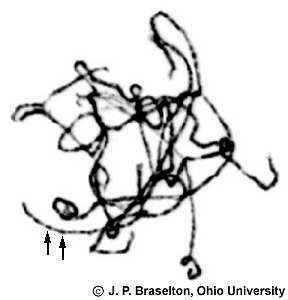Page 3: Pachynema

Pachynema in Mayapple. Leptonema and zygonema occur prior to pachynema. In leptonema, the chromosomes appear as very thin threads. During zygonema, the homologous chromosomes pair (synapsis). Pachynema is characterized by chromosomes having become completely paired. The paired homologues, now called bivalents, are still relatively long and twisted. The homologous chromosomes are so tightly appressed and twisted around each other that at this level of light microscopy the individual homologues and their chromatids cannot be resolved. The arrows in the photograph indicate chromomeres, which are localized compaction of the chromatin. Chromomeres have been used in cytogenetics as markers during mapping of chromosomes. At this stage transmission electron microscopy reveals a structure that occurs between the synapsed homologues—the synaptonemal complex, which is shown on the next page
Some treatments of meiosis refer to the synapsed homologous as "tetrads" instead of bivalents. They do this to emphasize that each pair of homologues consists of four chromatids, two in each of the homologous chromosomes. Use of the term tetrad in place of bivalent should be avoided. The term bivalent fits into an ordered system of names for chromosomes in meiosis. It is possible to have a chromosome that is not paired in meiosis or that has not remained attached to its homologue—such an unpaired chromosome is called a "univalent." In some situations, particularly in plants, it is possible to have three homologous chromosomes present: When they synapse during prophase I, the three homologous attached together form a "trivalent." Similarly, when four homologous chromosomes synapse, together they form a "tetravalent."
Another reason to avoid the use of tetrad for what should be called a bivalent is that the term tetrad is used for the four meiotic products together, particularly when referring to the products in plants. Viz., after meiosis the four spores are in a tetrad.

